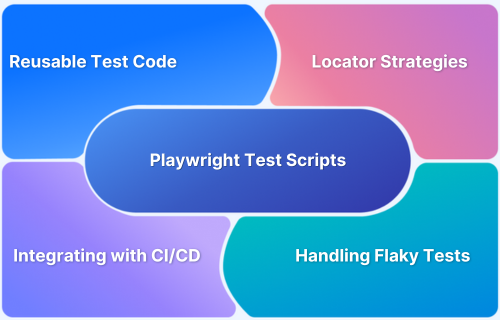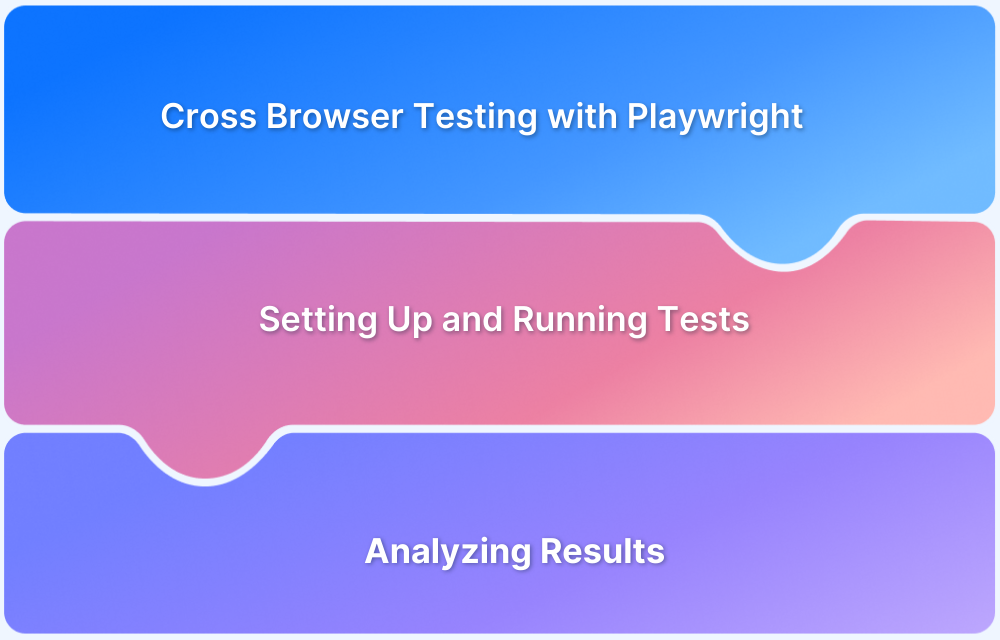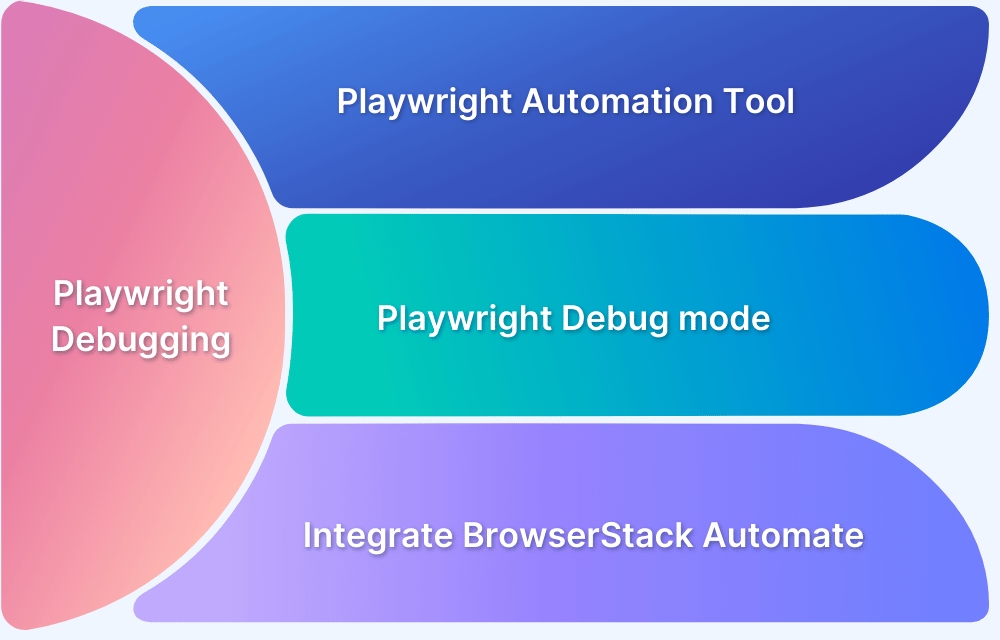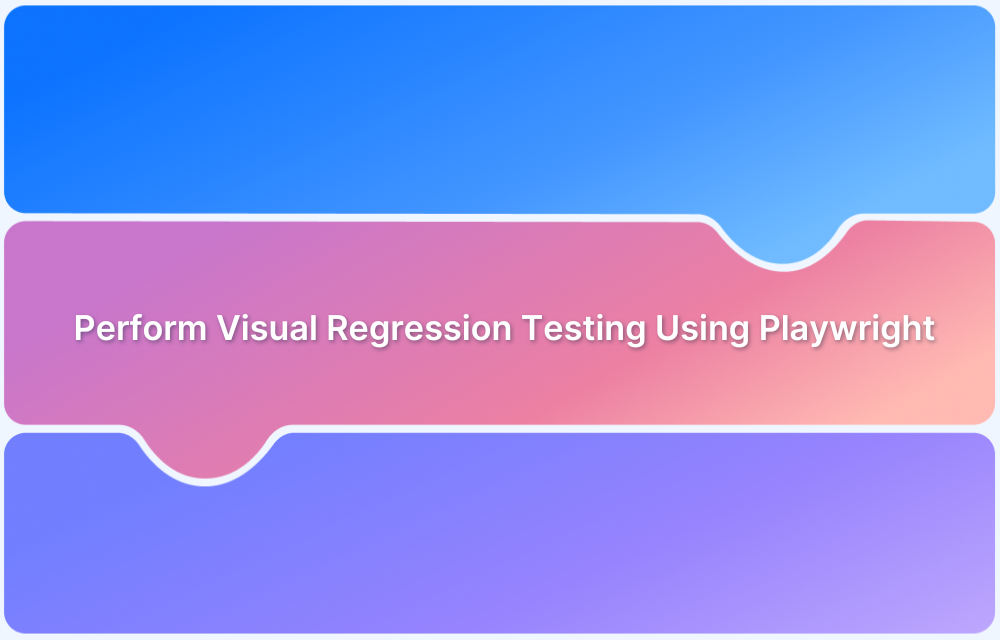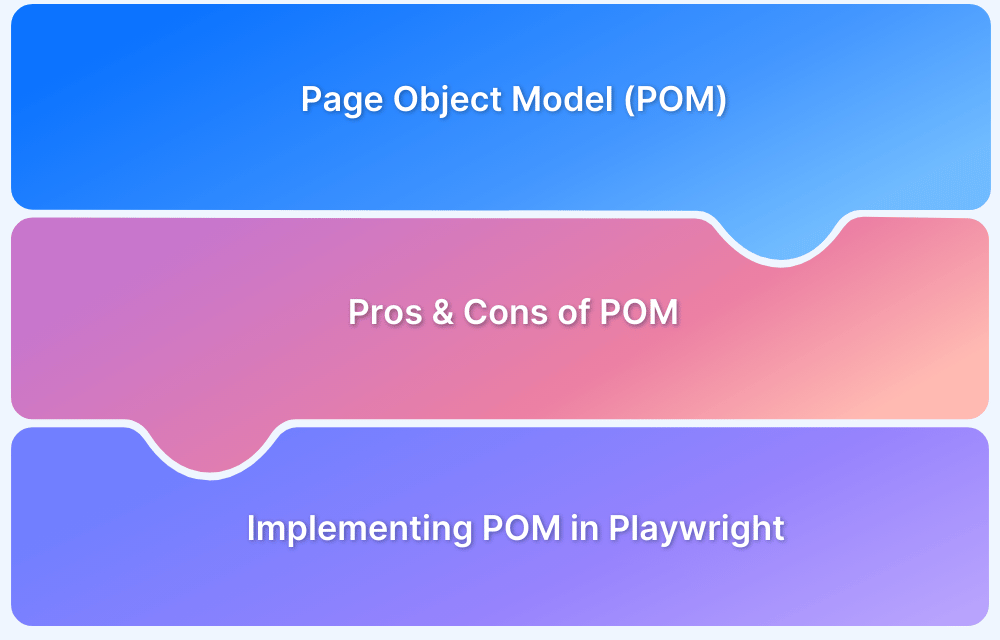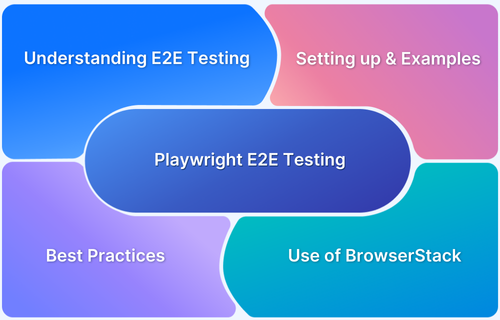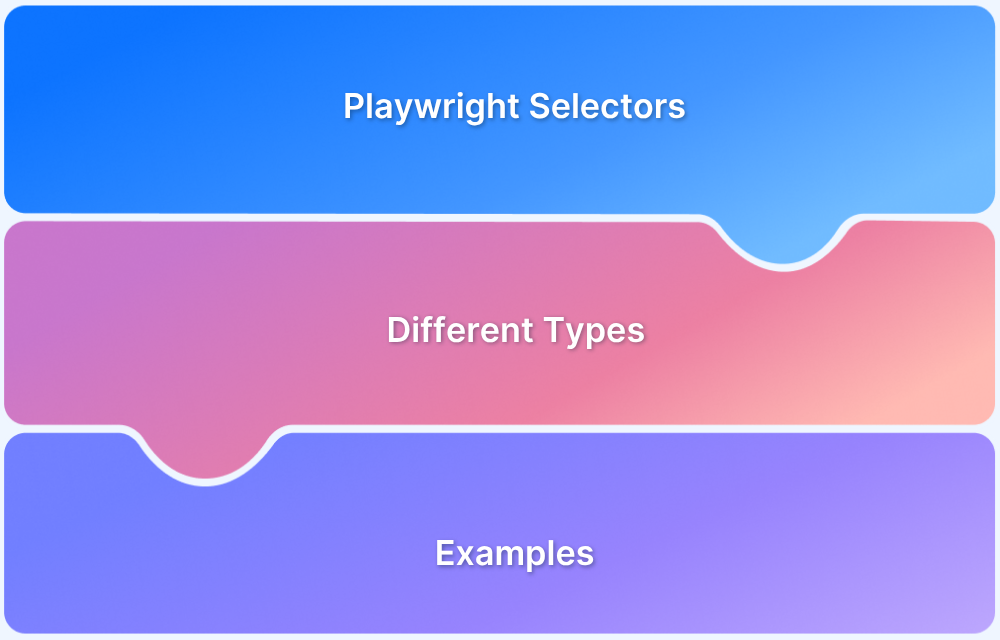Building scalable Playwright test scripts is essential for teams aiming to maintain speed, reliability, and coverage as applications grow.
Overview
Playwright scripts are automated test scripts that simulate real user interactions, such as navigation, clicks, form submissions, and assertions, across multiple browsers and devices. They enable developers to validate web application functionality, performance, and reliability through code-driven automation.
Key Elements and Functionalities of Playwright Scripts:
- Cross-browser and Cross-platform Support: Run tests on Chromium, Firefox, and WebKit browsers, as well as mobile and desktop platforms.
- Multi-language Support: Write scripts in JavaScript, TypeScript, Python, Java, and .NET for flexibility.
- Browser Contexts: Isolated browser sessions allow parallel tests without interference.
- Powerful Selectors: Advanced locator strategies including CSS, XPath, text selectors, iframe and Shadow DOM support.
- Auto-waiting: Built-in wait mechanisms that ensure elements are ready before interactions.
- Network Interception and Mocking: Ability to intercept and manipulate network requests for controlled testing.
- Headless and Headed Modes: Run tests either with or without GUI for CI or development environments.
- Screenshot and Video Recording: Capture visual artifacts to aid debugging and reporting.
- Parallel Execution: Support for running multiple workers simultaneously to speed up test runs.
- Test Generation Tools: Codegen feature to auto-generate test code based on recorded user actions.
- Robust Assertion APIs: Built-in assertions that wait for expected states, reducing flaky outcomes.
This article explores proven strategies for designing modular tests, optimizing locator usage, leveraging parallel and cross-browser testing, and integrating with CI/CD pipelines.
Understanding Scalability in Test Automation
Scalability in test automation refers to the ability of your test framework, scripts, and infrastructure to handle growing application complexity, larger test suites, and increased execution demands, without compromising speed, reliability, or maintainability.
As web applications evolve and teams adopt rapid release cycles, scalability ensures that test automation remains efficient, adaptable, and capable of supporting continuous delivery.
In the context of Playwright, scalability means designing test scripts that can run across multiple browsers, environments, and parallel instances while remaining stable and easy to maintain. A scalable Playwright setup allows teams to:
- Execute hundreds of tests in parallel across different browsers and devices.
- Reuse and extend existing test components without code duplication.
- Integrate seamlessly with CI/CD pipelines to enable continuous testing.
- Manage test data, configurations, and reporting effectively as the test suite grows.
By focusing on scalability from the start, QA and development teams can build Playwright test suites that not only validate current functionality but also adapt effortlessly to future requirements, supporting faster releases and higher product quality in 2026 and beyond.
Designing Modular and Reusable Test Code
Creating modular and reusable test code is essential for building scalable and maintainable Playwright test suites. Modular design breaks down tests into smaller, self-contained units focused on specific functionalities, making them easier to understand, update, and reuse.
By following design patterns like the Page Object Model (POM) and separating test logic from UI interactions, teams reduce redundancy and improve test reliability.
Key practices include:
- Modularization: Divide automation scripts into independent, focused modules that represent distinct features or workflows.
- Page Object Model (POM): Abstract UI elements and actions into page classes to isolate changes in the UI from test logic.
- Reusable Functions: Create helper functions for common actions like login, form submission, or navigation to eliminate duplicate code.
- Parameterization: Design test modules to accept input parameters, enabling broader reuse across different test scenarios.
- Consistent Naming and Documentation: Use clear naming conventions and document modules to enhance readability and collaboration.
- Single Responsibility Principle: Each module or function should have one responsibility, improving maintainability and test clarity.
This approach streamlines test development and maintenance, helping teams manage growing test suites more efficiently while improving test robustness and adaptability.
Example of a Page Object Model (POM) class with reusable async functions:
// loginPage.ts
import { Page } from ‘@playwright/test’;export class LoginPage {
constructor(private page: Page) {}async navigate() {
await this.page.goto(‘https://example.com/login’);
}async login(username: string, password: string) {
await this.page.fill(‘#username’, username);
await this.page.fill(‘#password’, password);
await this.page.click(‘#loginButton’);
}async isLoggedIn() {
await this.page.waitForSelector(‘#dashboard’);
return await this.page.isVisible(‘#dashboard’);
}
}
Usage in a test:
import { test, expect } from ‘@playwright/test’;
import { LoginPage } from ‘./loginPage’;
test(‘User can login’, async ({ page }) => {
const loginPage = new LoginPage(page);
await loginPage.navigate();
await loginPage.login(‘testuser’, ‘password123’);
expect(await loginPage.isLoggedIn()).toBe(true);
});
Efficient Locator Strategies to Minimize Flakiness
Choosing the right locators is critical to writing stable and maintainable Playwright tests. Efficient locator strategies reduce test flakiness caused by dynamic UI changes and unpredictable loading times.
- Prioritize User-Facing Attributes: Use selectors based on accessibility roles (getByRole), labels, and visible text, which tend to be more stable and meaningful to users.
- Use Custom Data Attributes: Add and leverage attributes like>
Leveraging Parallel and Cross-Browser Testing
Maximizing test efficiency and coverage requires leveraging Playwright’s parallel and cross-browser testing capabilities. Playwright runs tests in parallel by default, distributing test files across multiple worker processes to speed up execution without compromising isolation or reliability.
- Parallel Execution: Tests in different files run simultaneously in separate workers, with options to control the number of parallel workers via config or command line.
- Configurable Parallelism: Use the fullyParallel option to enable running all tests across files and inside files in parallel for faster test runs.
- Isolated Browser Contexts: Each test runs in an independent browser context, preventing state leakage between parallel tests.
- Cross-Browser Support: Test on Chromium, Firefox, and WebKit browsers seamlessly within the same test suite to ensure broad compatibility.
- Execution Modes: Customize test execution with modes like serial, default, and parallel to balance concurrency and sequential dependencies.
- CI/CD Integration: Easily integrate parallel and cross-browser tests into pipelines via configuration, optimizing continuous testing workflows.
Harnessing these features accelerates feedback cycles, improves test coverage, and enhances test suite scalability, enabling robust automation even for complex web applications.
Example Playwright configuration (playwright.config.ts) for parallel and cross-browser testing:
import { defineConfig, devices } from ‘@playwright/test’;
export default defineConfig({
projects: [
{ name: ‘Chromium’, use: { …devices[‘Desktop Chrome’] } },
{ name: ‘Firefox’, use: { …devices[‘Desktop Firefox’] } },
{ name: ‘WebKit’, use: { …devices[‘Desktop Safari’] } },
],
workers: 4, // Run tests in parallel with 4 workers
fullyParallel: true, // Run tests within files in parallel as well
retries: 1,
});
Read More: Playwright Test Report: Comprehensive Guide
Integrating with CI/CD Pipelines for Continuous Testing
Integrating Playwright tests with CI/CD pipelines automates end-to-end testing, allowing tests to run reliably with every code change. This continuous testing approach helps catch issues early and accelerates feedback loops.
Key integration strategies include:
- Automated Test Execution: Configure CI tools like GitHub Actions, GitLab CI, or Jenkins to trigger Playwright tests on code pushes, pull requests, or scheduled runs.
- Consistent Test Environments: Use Docker or virtual environments preconfigured with required browsers and dependencies for stable and reproducible test runs.
- Parallel Execution in CI: Leverage Playwright’s parallelism to run multiple test workers concurrently, reducing total pipeline runtime.
- Artifact Management: Save test reports, screenshots, and videos from failed tests as pipeline artifacts for effortless debugging.
- Environment Configuration: Pass environment variables and secrets securely within CI to handle different testing environments.
- Selective Testing: Run critical smoke tests on every commit and full test suites on nightly or release builds for balance between speed and coverage.
- Integration with Notifications: Connect test outcomes to messaging platforms or dashboards for real-time visibility.
This integration ensures high-quality software delivery by embedding reliable automated testing within the development lifecycle.
Integrating with CI/CD Pipelines for Continuous Testing
Sample GitHub Actions workflow (.github/workflows/playwright.yml) to run Playwright tests:
name: Playwright Testson:
push:
branches:
– main
pull_request:jobs:
test:
runs-on: ubuntu-latest
steps:
– uses: actions/checkout@v3– name: Setup Node.js
uses: actions/setup-node@v3
with:
node-version: 18– name: Install dependencies
run: npm install– name: Run Playwright tests
run: npx playwright test –reporter=line,json– name: Upload test artifacts
if: failure()
uses: actions/upload-artifact@v3
with:
name: playwright-artifacts
path: playwright-report/
Handling Flaky Tests and Test Stability
Flaky tests-those that unpredictably pass or fail-can undermine confidence and slow down development. Reducing flakiness improves test reliability and accelerates delivery.
Key strategies to handle flaky tests and enhance stability include:
- Leverage Playwright’s Auto-Waiting: Playwright automatically waits for elements to be ready (visible, enabled) before interaction, reducing timing-related failures.
- Avoid Hardcoded Waits: Replace fixed delays (e.g., waitForTimeout(3000)) with condition-based waits like waitForSelector() or Playwright’s built-in assertions to make tests more resilient to performance variations.
- Use Stable Locators: Prefer stable selectors using roles, labels, and custom attributes (data-testid) over brittle CSS or XPath selectors that change frequently.
- Implement Retry Logic: Utilize Playwright’s retries configuration or custom retry code to re-execute flaky tests automatically in CI environments.
- Isolate Test State: Clear local storage, cookies, and cache between tests using hooks such as afterEach() to avoid state contamination across tests.
- Monitor and Debug: Use Playwright’s tracing, screenshots, and video recording features to capture detailed information on test failures for quicker root cause analysis.
- Tag and Separate Flaky Tests: Mark flaky tests with tags and run them separately to prevent them from blocking the main test suite while investigations continue.
By systematically applying these practices, teams can significantly reduce flaky tests, stabilizing their CI/CD pipelines and improving overall test suite reliability.
Read More: Web Scraping with Playwright
Scaling Test Maintenance and Reporting
Maintaining and scaling large Playwright test suites requires a strategic approach to organization, reporting, and collaboration.
Key practices include:
- Organized Test Structure: Use a clear folder hierarchy grouped by features, modules, or test types to make tests easy to locate and update.
- Page Object Model (POM): Encapsulate UI locators and actions within page classes to centralize changes and reduce duplication.
- Centralized Test Data Management: Store test data in external JSON, CSV files, or environment variables to avoid hardcoding and improve maintainability.
- Consistent Naming Conventions: Use descriptive test and file names for readability and better reporting.
- Reusable Fixtures and Utilities: Share setup/teardown logic and common functions across tests to improve efficiency and consistency.
- Robust Reporting: Integrate test reports and logs with dashboards or CI tools for visibility and quicker issue resolution.
- Test Tagging and Filtering: Categorize tests by priority or feature to run targeted suites quickly, enhancing feedback speed.
Adopting these strategies streamlines test upkeep, facilitates team collaboration, and ensures your Playwright automation scales smoothly as your application grows.
Scale and Accelerate Your Playwright Tests with BrowserStack Automate
BrowserStack Automate provides a comprehensive, cloud-based platform to run Playwright tests at scale on real browsers and devices. It enhances test reliability, speed, and coverage with the following features:
- Access to 3500+ Real Devices and Browsers: Test across a wide variety of device and browser combinations including real iOS Safari and Android devices, ensuring authentic user environments beyond emulation.
- High-Scale Parallel Execution: Run hundreds of Playwright tests concurrently without local resource constraints, drastically reducing overall test execution time.
- Seamless Integration: Connect your existing Playwright test suites with BrowserStack using their SDK with minimal or no code changes, enabling instant scalability.
- Smart Locator Healing AI: BrowserStack’s AI agent automatically detects and repairs broken locators during test execution, reducing flaky tests and keeping your pipeline green.
- Comprehensive Debugging Tools: Access detailed logs, videos, screenshots, network captures, and Playwright Trace Viewer combined in a unified dashboard for deeper root cause analysis.
- CI/CD Pipeline Friendly: Easily embed your Playwright tests in Jenkins, GitHub Actions, GitLab, and other pipelines, enabling continuous testing with automatic infrastructure management.
- Secure Local Testing: Test applications hosted behind firewalls or on local development machines securely using BrowserStack’s local testing tunnels.
By leveraging BrowserStack Automate, teams can significantly scale and accelerate their Playwright test automation with higher stability, faster feedback, and broader platform coverage, all managed effortlessly in the cloud.
Conclusion
Writing scalable and maintainable Playwright test scripts is essential for efficient, reliable, and adaptable test automation as applications grow. By adopting modular design patterns, leveraging robust locator strategies, and utilizing parallel and cross-browser testing, teams can build resilient test suites that provide fast and accurate feedback.
Integrating tests seamlessly into CI/CD pipelines and proactively managing flaky tests further improves stability and accelerates delivery cycles.
Additionally, scaling maintenance through organized structures and powerful reporting ensures long-term success. Harnessing cloud platforms like BrowserStack Automate unlocks unparalleled scalability and speed, empowering teams to confidently deliver high-quality software in today’s dynamic development environments.
Useful Resources for Playwright
- Playwright Automation Framework
- Playwright Java Tutorial
- Playwright Python tutorial
- Playwright Debugging
- End to End Testing using Playwright
- Visual Regression Testing Using Playwright
- Mastering End-to-End Testing with Playwright and Docker
- Page Object Model in Playwright
- Scroll to Element in Playwright
- Understanding Playwright Assertions
- Cross Browser Testing using Playwright
- Playwright Selectors
- Playwright and Cucumber Automation
Tool Comparisons:
